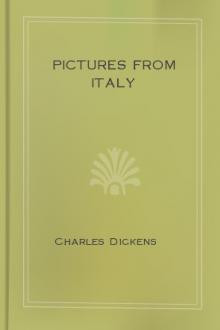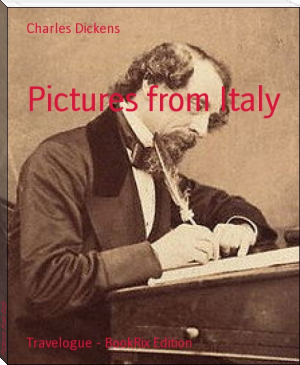Pictures From Italy by Charles Dickens (spicy books to read .TXT) 📕

- Author: Charles Dickens
- Performer: -
Book online «Pictures From Italy by Charles Dickens (spicy books to read .TXT) 📕». Author Charles Dickens
All this, and every other kind of out-door life and stir, and macaroni-eating at sunset, and flower-selling all day long, and begging and stealing everywhere and at all hours, you see upon the bright sea-shore, where the waves of the bay sparkle merrily. But, lovers and hunters of the picturesque, let us not keep too studiously out of view the miserable depravity, degradation, and wretchedness, with which this gay Neapolitan life is inseparably associated! It is not well to find Saint Giles’s so repulsive, and the Porta Capuana so attractive. A pair of naked legs and a ragged red scarf, do not make ALL the difference between what is interesting and what is coarse and odious? Painting and poetising for ever, if you will, the beauties of this most beautiful and lovely spot of earth, let us, as our duty, try to associate a new picturesque with some faint recognition of man’s destiny and capabilities; more hopeful, I believe, among the ice and snow of the North Pole, than in the sun and bloom of Naples.
Capri—once made odious by the deified beast Tiberius—Ischia, Procida, and the thousand distant beauties of the Bay, lie in the blue sea yonder, changing in the mist and sunshine twenty times a-day: now close at hand, now far off, now unseen. The fairest country in the world, is spread about us. Whether we turn towards the Miseno shore of the splendid watery amphitheatre, and go by the Grotto of Posilipo to the Grotto del Cane and away to Baiae: or take the other way, towards Vesuvius and Sorrento, it is one succession of delights. In the last-named direction, where, over doors and archways, there are countless little images of San Gennaro, with his Canute’s hand stretched out, to check the fury of the Burning Mountain, we are carried pleasantly, by a railroad on the beautiful Sea Beach, past the town of Torre del Greco, built upon the ashes of the former town destroyed by an eruption of Vesuvius, within a hundred years; and past the flat-roofed houses, granaries, and macaroni manufactories; to Castel-a-Mare, with its ruined castle, now inhabited by fishermen, standing in the sea upon a heap of rocks. Here, the railroad terminates; but, hence we may ride on, by an unbroken succession of enchanting bays, and beautiful scenery, sloping from the highest summit of Saint Angelo, the highest neighbouring mountain, down to the water’s edge—among vineyards, olive-trees, gardens of oranges and lemons, orchards, heaped-up rocks, green gorges in the hills—and by the bases of snow-covered heights, and through small towns with handsome, dark-haired women at the doors—and pass delicious summer villas—to Sorrento, where the Poet Tasso drew his inspiration from the beauty surrounding him. Returning, we may climb the heights above Castel-a-Mare, and looking down among the boughs and leaves, see the crisp water glistening in the sun; and clusters of white houses in distant Naples, dwindling, in the great extent of prospect, down to dice. The coming back to the city, by the beach again, at sunset: with the glowing sea on one side, and the darkening mountain, with its smoke and flame, upon the other: is a sublime conclusion to the glory of the day.
That church by the Porta Capuana—near the old fisher-market in the dirtiest quarter of dirty Naples, where the revolt of Masaniello began—is memorable for having been the scene of one of his earliest proclamations to the people, and is particularly remarkable for nothing else, unless it be its waxen and bejewelled Saint in a glass case, with two odd hands; or the enormous number of beggars who are constantly rapping their chins there, like a battery of castanets. The cathedral with the beautiful door, and the columns of African and Egyptian granite that once ornamented the temple of Apollo, contains the famous sacred blood of San Gennaro or Januarius: which is preserved in two phials in a silver tabernacle, and miraculously liquefies three times a-year, to the great admiration of the people. At the same moment, the stone (distant some miles) where the Saint suffered martyrdom, becomes faintly red. It is said that the officiating priests turn faintly red also, sometimes, when these miracles occur.
The old, old men who live in hovels at the entrance of these ancient catacombs, and who, in their age and infirmity, seem waiting here, to be buried themselves, are members of a curious body, called the Royal Hospital, who are the official attendants at funerals. Two of these old spectres totter away, with lighted tapers, to show the caverns of death—as unconcerned as if they were immortal. They were used as burying-places for three hundred years; and, in one part, is a large pit full of skulls and bones, said to be the sad remains of a great mortality occasioned by a plague. In the rest there is nothing but dust. They consist, chiefly, of great wide corridors and labyrinths, hewn out of the rock. At the end of some of these long passages, are unexpected glimpses of the daylight, shining down from above. It looks as ghastly and as strange; among the torches, and the dust, and the dark vaults: as if it, too, were dead and buried.
The present burial-place lies out yonder, on a hill between the city and Vesuvius. The old Campo Santo with its three hundred and sixty-five pits, is only used for those who die in hospitals, and prisons, and are unclaimed by their friends. The graceful new cemetery, at no great distance from it, though yet unfinished, has already many graves among its shrubs and flowers, and airy colonnades. It might be reasonably objected elsewhere, that some of the tombs are meretricious and too fanciful; but the general brightness seems to justify it here; and Mount Vesuvius, separated from them by a lovely slope of ground, exalts and saddens the scene.
If it be solemn to behold from this new City of the Dead, with its dark smoke hanging in the clear sky, how much more awful and impressive is it, viewed from the ghostly ruins of Herculaneum and Pompeii!
Stand at the bottom of the great market-place of Pompeii, and look up the silent streets, through the ruined temples of Jupiter and Isis, over the broken houses with their inmost sanctuaries open to the day, away to Mount Vesuvius, bright and snowy in the peaceful distance; and lose all count of time, and heed of other things, in the strange and melancholy sensation of seeing the Destroyed and the Destroyer making this quiet picture in the sun. Then, ramble on, and see, at every turn, the little familiar tokens of human habitation and every-day pursuits; the chafing of the bucket-rope in the stone rim of the exhausted well; the track of carriage-wheels in the pavement of the street; the marks of drinking-vessels on the stone counter of the wine-shop; the amphorae in private cellars, stored away so many hundred years ago, and undisturbed to this hour—all rendering the solitude and deadly lonesomeness of the place, ten thousand times more solemn, than if the volcano, in its fury, had swept the city from the earth, and sunk it in the bottom of the sea.
After it was shaken by the earthquake which preceded the eruption, workmen were employed in shaping out, in stone, new ornaments for temples and other buildings that had suffered. Here lies their work, outside the city gate, as if they would return to-morrow.
In the cellar of Diomede’s house, where certain skeletons were found huddled together, close to the door, the impression of their bodies on the ashes, hardened with the ashes, and became stamped and fixed there, after they had shrunk, inside, to scanty bones.
So, in the theatre of Herculaneum, a comic mask, floating on the stream when it was hot and liquid, stamped its mimic features in it as it hardened into stone; and now, it turns upon the stranger the fantastic look it turned upon the audiences in that same theatre two thousand years ago.
Next to the wonder of going up and down the streets, and in and out of the houses, and traversing the secret chambers of the temples of a religion that has vanished from the earth, and finding so many fresh traces of remote antiquity: as if the course of Time had been stopped after this desolation, and there had been no nights and days, months, years, and centuries, since: nothing is more impressive and terrible than the many evidences of the searching nature of the ashes, as bespeaking their irresistible power, and the impossibility of escaping them. In the wine-cellars, they forced their way into the earthen vessels: displacing the wine and choking them, to the brim, with dust. In the tombs, they forced the ashes of the dead from the funeral urns, and rained new ruin even into them. The mouths, and eyes, and skulls of all the skeletons, were stuffed with this terrible hail. In Herculaneum, where the flood was of a different and a heavier kind, it rolled in, like a sea. Imagine a deluge of water turned to marble, at its height—and that is what is called ‘the lava’ here.
Some workmen were digging the gloomy well on the brink of which we now stand, looking down, when they came on some of the stone benches of the theatre—those steps (for such they seem) at the bottom of the excavation—and found the buried city of Herculaneum.
Presently going down, with lighted torches, we are perplexed by great walls of monstrous thickness, rising up between the benches, shutting out the stage, obtruding their shapeless forms in absurd places, confusing the whole plan, and making it a disordered dream.
We cannot, at first, believe, or picture to ourselves, that THIS
came rolling in, and drowned the city; and that all that is not here, has been cut away, by the axe, like solid stone. But this perceived and understood, the horror and oppression of its presence are indescribable.
Many of the paintings on the walls in the roofless chambers of both cities, or carefully removed to the museum at Naples, are as fresh and plain, as if they had been executed yesterday. Here are subjects of still life, as provisions, dead game, bottles, glasses, and the like; familiar classical stories, or mythological fables, always forcibly and plainly told; conceits of cupids, quarrelling, sporting, working at trades; theatrical rehearsals; poets reading their productions to their friends; inscriptions chalked upon the walls; political squibs, advertisements, rough drawings by schoolboys; everything to people and restore the ancient cities, in the fancy of their wondering visitor. Furniture, too, you see, of every kind—lamps, tables, couches; vessels for eating, drinking, and cooking; workmen’s tools, surgical instruments, tickets for the theatre, pieces of money, personal ornaments, bunches of keys found clenched in the grasp of skeletons, helmets of guards and warriors; little household bells, yet musical with their old domestic tones.
The least among these objects, lends its aid to swell the interest of Vesuvius, and invest it with a perfect fascination. The looking, from either ruined city, into the neighbouring grounds overgrown with beautiful vines and luxuriant trees; and remembering that house upon house, temple on temple, building after building, and street after street, are still lying underneath the roots of all the quiet cultivation, waiting to be turned up to the light of day; is something so wonderful, so full of mystery, so captivating to the imagination, that one would think it would be paramount, and yield to nothing else. To nothing but Vesuvius; but the mountain is the genius of the scene. From every indication of the ruin it has worked, we look, again, with an absorbing interest to where its smoke is rising up into the sky. It is beyond us, as we





Comments (0)